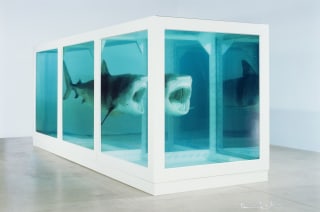Damien Hirst (b.1965)
Hirst is widely recognized as a leading figure in the contemporary art world, particularly within the Young British Artists (YBA) movement of the 1990s. Alongside well-known YBAs like Tracey Emin, Angus Fairhurst, and Jenny Saville, Hirst gained fame for his provocative and controversial art pieces, unafraid to push boundaries and shock audiences. Hirst is a widley commented on artists, often gathering large media attention and criticism for his bold and sometimes shocking artworks.
The themes of life and death are central to Hirst's artistic endeavors, and is evident in all his works. From seemingly unassuming spot paintings to controversial installations involving animal carcasses, Hirst's art carries deep symbolism and meaning, with symbolism playing a crucial role in the interpetation and understanding of Hirst's work. He embraces his unique style, breaking conventions, and forging his path in the art world.
Hirst's fascination with mortality is poignantly encapsulated in his 1992 art installation, "Pharmacy." This clean and minimalist recreation of an actual pharmacy, complete with white shelves stocked with medicines, artfully blends concepts of life and death, leaving a lasting impact on viewers.
Another notable work reflecting Hirst's morbid and unconventional flair is the 2007 sculpture "For the Love of God." First gaining recognition with his Turner Prize win in 1995, the sculpture features an 18th-century human skull covered in 8601 diamonds, with a large pear-shaped diamond attached to its forehead. The extravagant piece, costing Hirst and his team £12 million to produce, was eventually sold for £50 million to an anonymous consortium.
Another work that sent shockwaves throughout the art world was Hirst's 1991 installation "The Physical Impossibility of Death in the Mind of Someone Living." Preserving a 14-foot tiger shark in a tank filled with formaldehyde, the installation captures a moment that blurs the boundaries between life and death. This thought-provoking piece cost Hirst £50,000 to create and was later sold in 2004 to Steven A. Cohen for an undisclosed sum, solidifying its impact in the art community and beyond.
The artist has created a brand from himself, creating arguably a prevelant presence amongst the artworld. This is where a huge deal of the contorversy over this artist lies; as almost all of the work produced by Hirst is not physically made himself. Hirst has a close team of artists in which he enlists to turn his ideas into a reality. Much like a factory, Hirst has a team that work to create all his paintings, prints and installations.
